The Basic 5 Piece Place Setting includes
- Teaspoon
- Place Fork
- Place Knife
- Salad Fork
- Place Spoon
Other
Pieces that can be included in the Full Place Setting
- Cocktail or oyster fork**
- Iced beverage spoon
- Cream Soup Spoon
- Dinner Knife and
Fork
- Fish Knife and Fork
- Demitasse Spoon
**Note
that the cocktail or oyster fork is placed on the right side of the plate as shown in illustration A1. It is the only
fork that is placed on the right side of the plate.
| Illustration A |
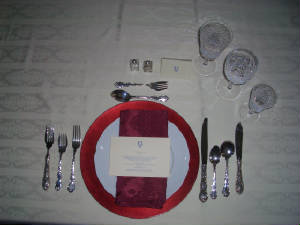
|
| Formal Dinner Setting With Fish Course |
| Illustration A1 |
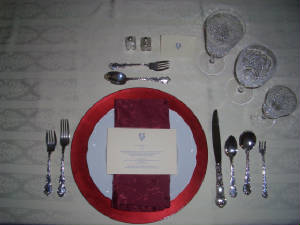
|
| Formal Dinner with cocktail fork |
| Illustration B |
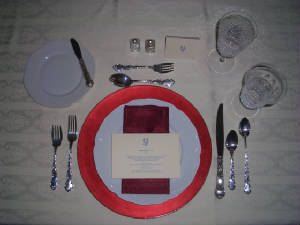
|
| Formal Luncheon Setting |
| Illustration C |
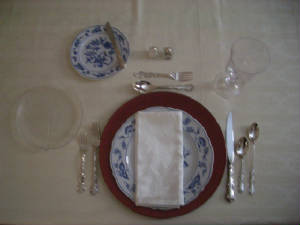
|
| Informal Setting |
The Illustrations below will introduce you to the various types of flatware.
There is a fuller explanation under the Settings button.
| Serving pieces |
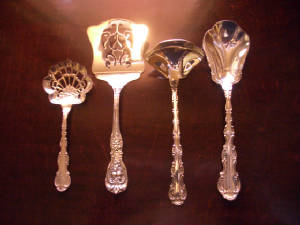
|
The serving pieces shown from left to right are:
- Bon Bon Server
- Pastry Server
- Sauce Ladle
- Sugar Shell
| forks |
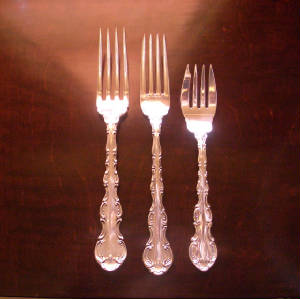
|
| dinner fork, luncheon fork, salad fork |
The forks shown above are from left to right:
- Dinner Fork used for the Entree or main course. There are two versions of this
fork, one slightly larger and heavier than the other with longer tines. It is often called a European Style Dinner Fork.
Though appealing, your guests may find it awkward to handle.
- Luncheon
Fork
- Salad fork. This can be used for salad or desserts or
pastries. Though they come in the 5 piece place setting, you will want extras of these. You will find that you
use them a lot.
| individual forks not in basic place setting |
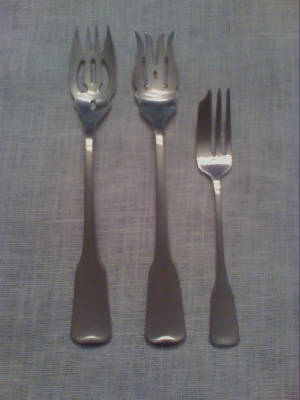
|
| fish fork, dessert fork and pastry fork |
| Fish, dessert, salad and pastry forks |
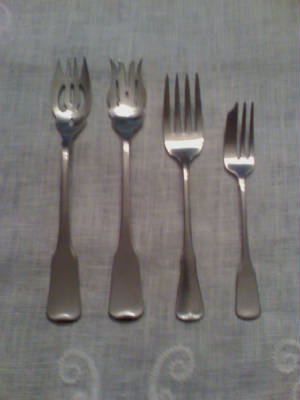
|
| Comparison of forks with salad fork |
These forks are in a more casual pattern than our other examples. We
have included these photos so that you can see the comparison of the different forks in the same pattern. It is not
necessary to have the full array of utensils because many can be used for various functions. In most cases having the
five piece place setting is adequate for almost any purpose. However, get additional teaspoons and salad forks because
they serve many purposes. For example, will include both the teaspoon and salad fork in your table setting and then
you will need the teaspoon and salad fork for your dessert and after dinner coffee. You can't be washing up the forks
and spoons in between courses to have enough.
| teaspoon, place spoon, cream soup spoon |
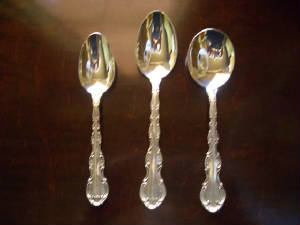
|
| 5 piece place setting includes tea and place spoons |
The three spoons you see above are:
- Teaspoon: Part of the basic place setting, this versatile piece is used
for fruit, desserts, coffee, tea, cereals and bouillon. You will want to have many of these as they will be used several
times during a meal. If you are hosting a tea or coffee these and possibly the salad fork will be all you need plus
the various serving pieces. So, if you are just starting out and don't expect to serve large dinners, start with the
teaspoons and salad forks. You could do a lot of entertaining with just these two items.
- Place spoon: This is also part of your basic place setting. It can
be used for clear soups, like the teaspoon it can be used for cereal and dessert. It can be pressed into service as a small
serving piece.
- Soup spoon: This is a
cream soup spoon. It does not come with the basic place setting but will be a useful addition as you expand your pieces.
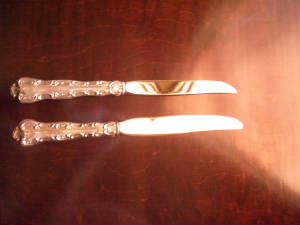
The knife on the bottom is the place knife and will be used for the
entree or main course. There is a slightly smaller knife (not shown here) that is the exact same shape that is the luncheon
size. The knife above is a steak knife. You can see from the illustration that the steak knife is more slender
and comes to a point. However, what you can't see is that it is not serrated. This makes it virtually useless
for cutting steak. Generally the menu served at a formal dinner does not include an entree that would require cutting
to this extent. One reason is that the serrated knife edge would damage the finish on your fine china. Thus we
don't recommend getting steak knives. Also, keep this in mind when selecting your menu.
| Butter Knives |
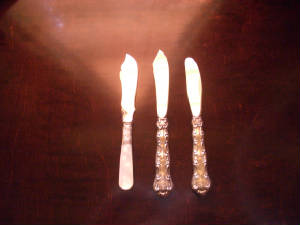
|
| butter knives and individual butter spreader |
The two examples on the
left are butter knives. One has a pearl handle and the one in the center is sterling. They are to be used when
serving the butter. The knife in the right is an individual butter spreader and is put on the bread and butter plate.
Though it is supposed to be placed parallel to the forks the plate may not cooperate and it is acceptable to place it at angle
on the upper right side of the plate. When serving yourself butter, you use the butter knife to cut a piece from the
stick or scrape from the molded butter and place it on your bread and butter plate. You replace the butter knife on
the serving piece and use your individual butter spreader to apply the butter to your bread.
| Fish fork and knife |

|
The fish knife and fork
are shown in illustration A. The custom is to place no more than three forks and four items to the right of the plate
at one time. Therefore, if you are serving a fish course with fish fork and knife you will want to omit the salad knife.
Other
utensils
The following items are not often seen and rarely used. If you have any of them, you can more
or less use them as you wish because it is unlikely that anyone will know the difference between a lettuce fork and a strawberry
fork.
| Various other serving pieces |
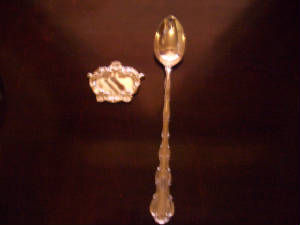
|
| iced tea spoon and spoon rest shown separately |
| iced tea spoon on spoon rest |
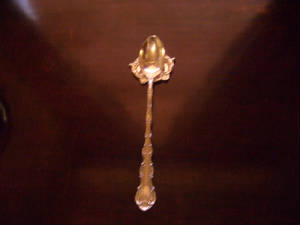
|
| the decorative spoon rest can be used with other items |
| grapefruit spoon |
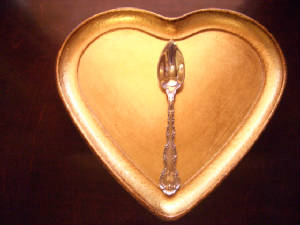
|
| can also be used for melon |
| Pastry servers |

|
| can be used for cakes, pies, tarts or other sweets |
| olive or pickle fork has two tines |

|
| lemon fork has three tines |
| left to right Bon Bon, pastry server |

|
| middle to right cream sauce ladle and sugar shell |
| lettuce fork |
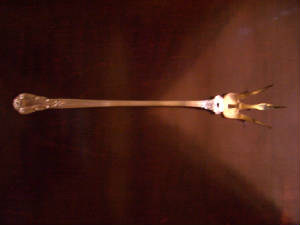
|
| can be used in place of other similarly shaped pieces |
| Strawberry fork |
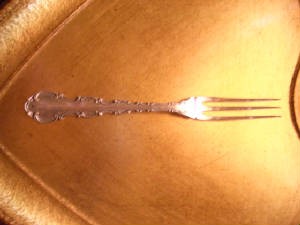
|
| can be used in place of other similar serving pieces |
We
added this as a novelty.
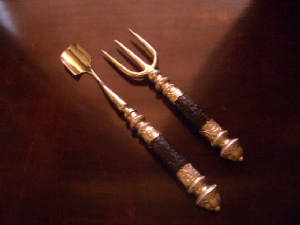
|
| Marrow fork and scoop |
Many dishes in Europe call for Marrow such as the Italian veal dish called
osso buco. These are not commonly seen in the U.S.